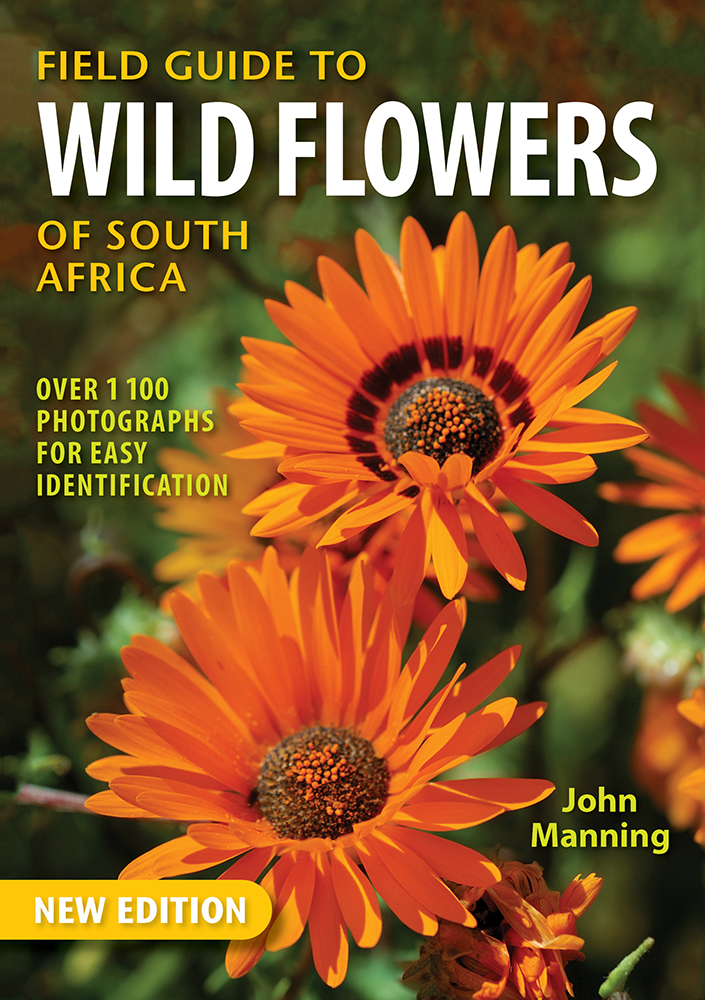Photo Guide to the Wildflowers of South Africa, by John Manning

Photo Guide to the Wildflowers of South Africa, by John Manning. Briza Publications. 2nd edition. Pretoria, South Africa 2012. ISBN 9781920217020 / ISBN 978-1-920217-02-0
John Manning's photo guide covers nearly 900 of the most common and conspicuous wildflowers that occur in South Africa and the neighbouring countries. The choice of species is the result of many years' experience in the field by the author.
Wildflower regions and climate
The natural vegetation of southern Africa can be divided into seven broad classes based on the dominant types of plants that occur in them, including such groups as trees, grasses and other herbaceous perennials, or annual herbs. The classes are termed biomes and each is defined by the dominant lifestyle found among its component plants. These lifestyles are a direct response to climatic factors, especially the average annual rainfall, the season in which most of it falls and the degree of summer aridity. The biomes are defined, therefore, on the structure of the vegetation rather than on the identity of the individual species. No less than eight different biomes occur in South Africa alone (although the Desert Biome is largely restricted to the Namibian coast and enters South Africa only along the lower reaches of the Orange, or Gariep, River). The large number of biomes that occur in South Africa is a reflection of the great variation in climate that occurs across the country. Climate is the prime determinant for the diversity of wildflowers that characterise a region and is, in turn, determined by its geography, latitude (and therefore the weather systems associated with it), and the ocean currents that pass along its coasts. The eastern and western shores of southern Africa are washed by two very different currents, with dissimilar effects on their rainfall. In the east the Agulhas current flows southwards, bringing warm tropical water with it and raising the humidity of the air above it to levels that sustain the lush, subtropical vegetation that characterises the eastern seaboard. The west coast, in sharp contrast, is an arid desert, the result of the cold Benguela current that sweeps northwards from the southern polar region, lowering the humidity and reducing rainfall. Here the vegetation is dominated by a dwarf succulent shrubland. Between these two different coasts is the central plateau, which supports temperate grassland in the east and a semi-arid scrubland in the west. This plateau drops dramatically along the Drakensberg to the coastal plain in the east; to the west it slopes gently and then drops gradually to the coast. To the south the coastal forelands have been folded into the parallel ranges of sandstone rock that form the towering ramparts of the Cape Fold mountains, which are the bastion of fynbos shrubland. Compounding the differences in the coastal currents is the influence of two distinct weather systems. The bulk of the country comes under the sway of a tropical high-pressure system that prevents warm, moisture-laden air from the Indian Ocean reaching the interior in winter. The result is that the central and eastern parts of the country receive the bulk of their rain during the summer months, in the form of thunderstorms and showers carried from the Indian Ocean by north-easterly winds. In contrast, the south-western part of the country receives the bulk of its rain in winter, when it comes under the influence of a low-pressure system that moves north at this time of the year. From April to September westerly winds drive a series of cold fronts across the southern part of the country, depositing rain in their wake. Sandwiched between these two regions is a narrow band that receives relatively little rain throughout the year. South Africa's biomes are the result of the interplay between these geographical and climatological influences.
This is an excerpt from the guide: Photo Guide to the Wildflowers of South Africa, by John Manning.
Title: Photo Guide to the Wildflowers of South Africa
Author: John Manning
Publisher: Briza Publications
2nd edition. Pretoria, South Africa 2012
ISBN 9781920217020 / ISBN 978-1-920217-02-0
Softcover, 17 x 24 cm, 352 pages, distribution maps, 900 colour photographs
Manning, John im Namibiana-Buchangebot
Photo Guide to the Wildflowers of South Africa
This excellent photo guide includes nearly 900 of the most common and conspicuous wildflowers that occur in South Africa and the neighbouring countries of Lesotho, Swaziland and Namibia.
The lycopods and ferns of the Drakensberg and Lesotho
The lycopods and ferns of the Drakensberg and Lesotho is the most comprehensive account of lycopod and fern species occurring in the Drakensberg and Lesotho region.
Field Guide to Wild Flowers of South Africa
Manning's Field Guide to Wild Flowers describes more than 1100 of shrubs and herbs of South Africa.
South Africa's Floral Kingdom (Hoberman)
South Africa's Floral Kingdom is the collaboration of Gerald Hoberman and John Manning, an authority on the South African flora.
Ecoguide Namaqualand
This Ecoguide describes 200 wildflowers and their background on birds, insects, spiders, reptiles and mammals of Namaqualand.
Ecoguide Fynbos
This ecoguide introduces 400 wildflowers and birds, insects, spiders, reptiles and mammals in their environment in the Fynbos region of South Africa.
Field Guide to Fynbos
Field Guide to Fynbos features 1150 species of Fynbos, focusing on the most common and conspicuous wild flowers of South Africa.
First Field Guide to Succulents of Southern Africa
Information at a glance through superb photographs, maps and easy-to-read text
Southern African Wild Flowers: Jewels of the Veld
Celebrates the beauty of Southern African wild flowers that truely are to be said the jewels of the veld along the landscapes.
Wild Flowers of South Africa
Offers a glimpse into South Africa’s rich floral heritage, enabling the reader to enjoy our most spectacular flowers
First Field Guide to Wild Flowers of Southern Africa
First Field Guide to Wild Flowers of Southern Africa is an invaluable resource for the beginner, providing information at a glance through superb photographs, maps and easy-to-read text.












